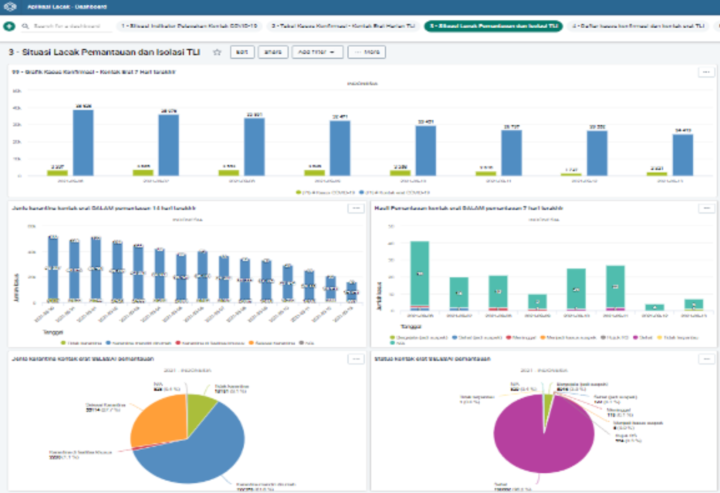DHIS2 for integrated and effective COVID-19 contact tracing in Indonesia
Indonesia’s DHIS2-based SILACAK system features integration with lab test data and case monitoring systems, user registration via WhatsApp, and more
The first cases of the novel coronavirus SARS-CoV2 in Indonesia were reported on March 2, 2020. As in most parts of the world, the number of cases quickly began to increase. The public demanded transparency on COVID-19 data, and the government responded with a number of initiatives to address this crisis. Testing and contact tracing was identified as one key area of focus, to help identify new cases of the virus and attempt to reduce transmission to slow or stop its spread. Indonesian health authorities recognized the need for robust digital tools to support contact tracing, as well as to collect and analyze a large variety of data related to COVID-19.
DHIS2 was already in use in Indonesia as Health Management Information System (HMIS) platform before the pandemic began. HISP Indonesia worked with the Indonesian Ministry of Health to adapt and deploy a version of the DHIS2 COVID-19 metadata packages, translated to Indonesian and customized to meet local needs and workflows, including through the development of several custom applications and integrations. This system, known as SILACAK, is Indonesia’s official contact tracing tool. The system includes both aggregate and case-based data, and is used both to register and monitor individual COVID-19 cases and contacts, and to perform data processing and analysis at regional and national scale.

Developing a contact tracing application through DHIS2 that supports decision making and online and offline data capture across all of Indonesia
In designing SILACAK as a contact tracing platform, HISP Indonesia first created a dashboard following national guidelines to monitor COVID-19 cases in Indonesia and support decision-making for stakeholders (including decisions on pandemic-related travel restrictions) through data visualization and forecasting. Key outputs of the dashboard include information on total COVID-19 case number and status, and contact tracing cases and monitoring status (including quarantine).
This dashboard is populated with data from various sources, including the SILACAK contact tracing application (built on DHIS2 Tracker), which allows contact tracers to enter data on individual cases, including personal information such as patient name, contact number, lab test date, and civil records ID number, and conduct monitoring and follow-up activities with the patients based on national guidelines. Between November 2020 and February 2021, the MoH and the National Taskforce recruited around 6,000 contact tracers to work in 13 priority provinces. This later expanded to the remaining 21 provinces in Indonesia, for a total of approximately 80,000 contact tracers.
To meet the needs of contact tracers and users in areas without reliable internet access, HISP Indonesia developed a mobile version, designed as a progressive web application, supporting data collection in offline mode. This application also includes a monitoring table to make it easier for contact tracers to monitor their active close contact cases, and has been improved in subsequent versions to meet additional user needs, such as transferring cases between organisation units. HISP Indonesia also developed an integration between DHIS2 and the national lab testing system (NAR), so that positive PCR and antigen test results generate new records in SILACAK that are assigned to the appropriate contact tracers based on each patient’s place of residence. This makes contract tracing much more efficient, as users no longer need to enter case data manually one case at a time.
Making it easier to manage DHIS2 accounts for 80,000 users through WhatsApp integration, and for the public to access information related to their COVID-19 status
Creating and managing DHIS2 user accounts for 80,000 people located across a country as large as Indonesia is no small task. To make this easier and faster for both data managers and users, HISP Indonesia developed an innovative self-registration tool (AMICA) based on WhatsApp. This tool, which is integrated with the DHIS2 SILACAK system, allows users to engage with a chat bot to register and receive their personal account information. The accounts created in this way can be accepted directly by data managers at the district level through a custom approval system based on the DHIS2 User Management application. Thanks to this innovation, the process of creating a user account that previously took a lot of time has become efficient and effective.
In addition to contact tracing users, SILACAK also facilitates information use by the citizens through integration with the PeduliLindungi application. This app, which was created by the government of Indonesia, helps facilitate the return to a “new normal” by supporting case tracking, information sharing, and travel restrictions, depending on current pandemic guidelines and individual status. Members of the public can download and use this app to view and display their COVID-19 status, which is based on information from the DHIS2 system. This can make it easier for authorities to monitor close contact cases and compliance with quarantine procedures and travel restrictions to further control the spread of COVID-19.

HISP Indonesia continues to support Indonesian authorities in the fight against COVID-19
By mid-September 2021, eighteen months after COVID-19 began to spread in Indonesia, the country had reported 4,188,529 confirmed cases of COVID-19 of which 3,983,140 patients recovered, 140,323 patients died, and the remaining were still in treatment. The country began its COVID-19 vaccination campaign in January 2021. 37.96% of the target population of 208,265,720 citizens had gotten the first dose by mid-September, and 21.58% had received a second dose. Live data on COVID-19 in Indonesia are shared through a public website, which includes data from the SILACAK contract tracing system: https://vaksin.kemkes.go.id/
The government and other stakeholders continue their efforts to decrease the numbers and stop the spread of COVID-19 in Indonesia, and HISP Indonesia continues to provide support for digital tools, including ongoing support for contact tracing with SILACAK.
Watch a presentation on this project from the 2021 DHIS2 Annual Conference and read more about HISP Indonesia’s work with SILACAK on the DHIS2 Community of Practice


